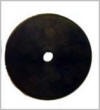There are several different types of plungers available to clear partially or completely clogged drains, but all use basically the same principal. A plunger is used to create a positive or negative pressure inside the pipe to loosen the blockage and allow it to flow down the drain.
Sink Plunger
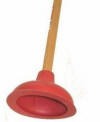 This is the standard plunger that we all recognize and has probably been around as long as indoor plumbing. Consisting of a pliable rubber cup and handle, this plunger is capable of creating both a positive pressure (by forcing the cup down) and a negative pressure (vacuum) when pulled away from the fixture. Variations on the design are typically limited to the size of the cup and length of the handle.
This is the standard plunger that we all recognize and has probably been around as long as indoor plumbing. Consisting of a pliable rubber cup and handle, this plunger is capable of creating both a positive pressure (by forcing the cup down) and a negative pressure (vacuum) when pulled away from the fixture. Variations on the design are typically limited to the size of the cup and length of the handle.
The sink plunger; as it name suggests, is best used on sinks or relatively flat fixtures to which it can create a suction seal. When using the sink plunger:
- Cover the overflow hole of the sink or tub;
- Keep the fixture partially full of water, because water is not easily compressed it will place a stronger force on the blockage;
- Plunge forcefully in both directions for several minutes until the drain clears.
Toilet Plunger
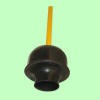 The toilet plunger is very similar to the sink plunger but has a larger cup and a fold out flap that will fit into the trap of the toilet. The flap can also be left folded in for use on sinks, floor drains and other fixtures. If used correctly this plunger will clear nearly all toilet clogs and should be your first line of defense before calling a plumber. To use a toilet plunger follow these steps:
The toilet plunger is very similar to the sink plunger but has a larger cup and a fold out flap that will fit into the trap of the toilet. The flap can also be left folded in for use on sinks, floor drains and other fixtures. If used correctly this plunger will clear nearly all toilet clogs and should be your first line of defense before calling a plumber. To use a toilet plunger follow these steps:
- Fold out the flap on the plunger;
- Keep the toilet about half full of water;
- Insert the plunger so that the folded out cup goes into the drain opening and try to form a suction seal with the toilet bowl;
- Being careful not to splash your self, forcefully plunge up and down several times and remove the plunger. Repeat adding more water if necessary.
Other Types Of Plungers
Accordion style plungers – Works very well with toilets but only at applying force. Not as versatile as the fold out toilet plunger. 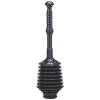
Air operated plunger – These work by forming a suction seal and releasing pressurized air into the drain. More of a gimmick than a functional plunger. Steer clear. 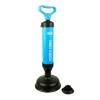
Taze plunger – Not a common tool but effective for clearing blockages in larger pipes. A steel rod with an attached disk; that is the same size as the internal pipe diameter, is forced into the pipe creating a high pressure zone. 